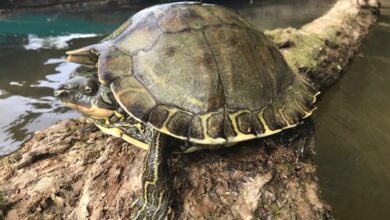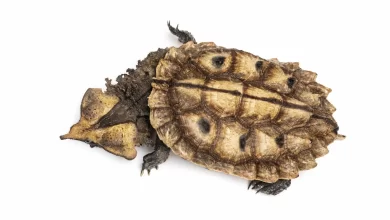Softshell Turtles
Meet the Incredible Softshell Turtles: Habitat, Features, and Behavior
Have you ever heard of a creature that’s like a ninja but lives underwater? Well, let me introduce you to the amazing Softshell Turtle! These fantastic reptiles may not wear black suits but can move swiftly and silently through the water.
Softshell turtles have a unique superpower – their shells are soft, like pancakes! Unlike other turtles with hard shells, these water-loving ninjas can easily bend and twist their bodies. This unique feature makes them excellent swimmers. They can glide through the water like fish, making it hard for predators to catch them.
But wait, there’s more! Softshell turtles also have long noses that look like snorkels. They use these snouts to breathe while staying hidden underwater. It’s like having a built-in scuba diving mask! How cool is that?
These turtles are known for their funny faces, too. Their big, round eyes and broad smiles always seem up to some mischief. Maybe they’re secretly planning their next prank!
In this guide, we will embark on a journey to explore the incredible softshell turtle’s habitat, features, and behavior.
Where They Originate From
Softshell turtles can be found in various parts of the world, including North America, Asia, and Africa. They are often seen in freshwater habitats such as rivers, lakes, and ponds.
These turtles are adaptable and can live in both warm and cool climates. So whether they’re chilling in the swamps of Florida or exploring the rivers of China, softshell turtles have made themselves at home in different corners of the globe.
It’s amazing how these incredible creatures have survived and thrived in such diverse environments. So next time you’re near a body of water, watch for these ninja-like turtles lurking beneath the surface!
Choosing and Buying
If you’re thinking about getting a softshell turtle as a pet, there are a few things you should consider. Here are some tips to help you choose and buy your new underwater ninja friend:
Do Your Research:
Before bringing home a softshell turtle, know their care requirements. These unique creatures have specific needs, so being well-informed is essential.
Find a Reputable Breeder or Pet Store:
Look for a seller who specializes in turtles and has a good reputation. This will ensure that you are getting a healthy and well-cared-for turtle.
Check the Turtle’s Health:
When you see a potential turtle, look at it. Make sure its eyes are bright and clear, its shell is smooth and free from any deformities or cracks, and it is active and alert.
Get the Right Setup:
Softshell turtles need a spacious tank with a filtration system and a basking area to dry off. Make sure you have everything set up and ready before bringing your turtle home.
Feed Them a Balanced Diet:
Softshell turtles are carnivorous, so they need a diet of live or frozen prey like fish, shrimp, and insects. You can also supplement their diet with commercial turtle food.
Be Prepared for a Long-Term Commitment:
Softshell turtles can live for several decades, so make sure you are ready for the responsibility of caring for them for their entire lifespan.
How To Care For Them
Caring for your softshell turtle doesn’t have to be a turtle-ly tricky task! Here are some fin-tastic tips to ensure your shelled friend stays happy and healthy:
Tank Time:
Provide a spacious tank with plenty of swimming room for your aquatic buddy.
Sun-Kissed:
Softshell turtles need a basking spot under a UVB lamp to soak up those rays.
Chow Time:
Feed your turtle a well-balanced diet of commercial turtle pellets, fresh veggies, and occasional treats like earthworms or crickets. Yum!
Clean and Clear:
Keep the tank clean by regularly removing any waste and debris. No one likes living in a messy home!
Doctor’s Orders:
Schedule regular check-ups with a reptile veterinarian to ensure your turtle is in tip-top shape.
With some love and fun in the sun, your softshell turtle will thrive in its underwater paradise. Turtle power, activate!
Handling
Handling your softshell turtle can be a shell of a good time! These little swimmers may look like they have a tough exterior but are pretty sensitive.
When picking up your turtle, it’s essential to be gentle and avoid sudden movements. Always support their body, just like giving them a big turtle hug! And remember, they’re not like cats or dogs – no belly rubs here!
Softshell turtles prefer to be left alone when they’re not swimming around. So give them their space and let them do their thing. Happy handling, shell-seekers!
Common Health Issues
As much as we love our softshell turtle friends, they’re not invincible superheroes. Just like us, they can have their fair share of health issues. Here are some common health concerns you might encounter along your turtle journey:
Shell Problems:
Sometimes, softshell turtles can develop cracks or lesions on their shells. These can be caused by poor water quality or rough handling. Make sure to keep their tank clean and handle them with care.
Respiratory Infections:
Turtles can also suffer from respiratory infections, just like humans. If you notice your turtle coughing, wheezing, or having trouble breathing, it’s time to consult the turtle doctor.
Parasites:
These sneaky critters can latch onto your turtle and cause trouble. Look for any signs of parasites, like lethargy or loss of appetite, and seek treatment if necessary.
Puffy Eyes:
Sometimes, softshell turtles can develop swollen or puffy eyes. This can be a sign of infection or irritation. If you notice this, it’s best to get them checked out by a reptile vet.
Remember, prevention is better than cure, so always provide a clean and healthy environment for your softshell turtle. And remember to give them lots of love and shelly good care!
Appearance and Behavior
Softshell turtles are a pretty exciting bunch regarding their appearance and behavior. These nifty little critters have a unique look with their soft, flat shells and long, tubular snouts. They almost look like they’re wearing a fancy turtle cape! But don’t let their appearance fool you. They’re not superheroes, just cool turtles.
When it comes to behavior, softshell turtles can be pretty entertaining. They’re excellent swimmers, darting through the water with their sleek bodies and powerful flippers. But they’re not just all about swimming. These turtles also enjoy an excellent sunbathing session, lounging on rocks or logs to soak up those warm rays. They’re like little sun-loving reptilian sunbathers!
So there you have it. Softshell turtles may have a unique appearance, but they’re just turtles having a blast in their underwater world. Dive in and enjoy the turtle-tastic show!
Size and Lifespan
Softshell turtles come in various sizes, but on average, they can grow 18-43 inches long. That’s like having a mini ninja turtle in your tank!
As for their lifespan, these little-shelled warriors can stick around for quite a while. Softshell turtles can live for 20 to 50 years with proper care and a little luck. That’s a whole lot of turtle power!
So remember, when you bring home a softshell turtle, you’re committing to a long-term relationship. Get ready for years of turtle-tastic adventures!
Temperament
Softshell turtles may look tough on the outside, but they’re softies with unique personalities on the inside!
These little water dwellers can be chill and laid-back, often lounging around and taking it easy. They’re not the type to get all riled up or go on shell-raising adventures. Think of them as the zen masters of the turtle world, floating along in their watery domain with a calm and collected demeanor.
So, if you’re looking for a low-maintenance companion who can relax and enjoy life, a softshell turtle is the perfect choice.
Housing Softshell turtles
When housing your softshell turtle, imagine it as creating its underwater paradise! Here are some tips to make sure your shelled friend feels right at home:
Hide and Seek:
Softshell turtles love to have hiding spots in their tank, like rocks or caves. It’s like having their turtle mansion!
Underwater Decor:
Add some aquatic plants and decorations to create a cozy and natural environment for your turtle. They’ll feel like they’re swimming in their very own tropical getaway!
No Skid Marks:
Ensure the tank bottom has a non-slip surface to prevent accidental slips and slides. We want our turtles to refrain from doing water acrobatics!
Keep it Clean:
Regularly clean the tank and replace the water to keep it fresh and healthy for your turtle. It’s like giving them a spa day!
Remember, a happy turtle is healthy, so create a comfortable and inviting home for your softshell friend. It’s shell-ebration time!
Enclosure Size
When it comes to housing your incredible softshell turtle, size matters! These little guys need plenty of room to stretch their flippers and explore.
Generally, a good rule of thumb is to provide an enclosure at least three times the length of your turtle’s shell. This will give them enough space to swim, bask, and roam. Remember, softshell turtles are active creatures needing room to wiggle.
A cramped home is no fun for anyone, not even turtles! So go big and watch your softshell turtle thrive in its spacious abode.
Lighting
The Incredible Softshell Turtle might be a master of disguise, but it still needs good lighting in its home. These turtles are active during the day, requiring a light source that mimics the sun.
A UVB bulb is essential for their overall health and helps them absorb the calcium they need for solid shells. You can even get creative with different colors to create a fun and vibrant environment for your turtle.
Just make sure not to use a disco ball, as we don’t want your turtle to think it’s party time! So, let there be light, and watch your softshell turtle shine!
Temperature and Humidity
Now that we’ve covered enclosure size and lighting let’s talk about temperature and humidity for our incredible softshell turtles. These turtles may be tough on the outside, but they still appreciate a cozy and comfortable environment.
Softshell turtles are cold-blooded creatures, which means they rely on their environment to regulate their body temperature. To keep them happy and healthy, you’ll want to maintain a temperature of around 75-85°F (24-29°C) in their enclosure. This can be achieved with the help of a reliable heat lamp or heating pad.
Humidity is also essential for softshell turtles, as it helps keep their skin moist and aids in shedding. Aim for a humidity level of around 60-80% by regularly misting the enclosure with water.
Substrate and Decoration
When creating the perfect habitat for your incredible softshell turtle, substrate, and decoration play a crucial role. Not only do they add aesthetic appeal to your turtle’s home, but they also provide essential elements for their well-being.
First, let’s talk about the substrate. A soft, sandy substrate works best for these turtles, as it mimics their natural environment. Think of it as their very own sandy beach! Not only will it be comfy for them to rest on, but it also makes cleaning up any messes a breeze. Just be sure to choose a substrate that doesn’t contain any harmful chemicals or sharp edges.
Now, let’s get creative with decorations! Softshell turtles love exploring and hiding, so adding rocks, logs, and even small caves will keep them entertained. It’s like an underwater playground for your shelled friend! Ensure everything is securely placed so your turtle doesn’t accidentally topple over.
Food and Water
Regarding food and water, the Incredible Softshell Turtle knows how to chow down and stay hydrated. These turtles have quite the appetite, gobbling up small fish, insects, crustaceans, and even plants. Talk about a diverse diet! Just provide a balanced meal to keep their shells strong and their bellies happy.
As for water, softshell turtles love a good soak. They need a deep water area in their enclosure to swim and splash around. Think of it as their swimming pool! And remember to change the water regularly to keep it fresh and clean. Cheers to a happy turtle with a full belly and a wet home!
Breeding
Breeding softshell turtles is an incredible process that ensures the survival of these fascinating creatures. When it’s time for these turtles to find their special someone, they embark on a quest for love that rivals any romantic comedy.
First, the male softshell turtle will strut his stuff, showing off his impressive swimming skills and fancy footwork. He’ll do a little dance to impress the ladies and let them know he’s ready for a relationship.
Once the female softshell turtle is suitably impressed, the courtship begins. The two lovebirds will engage in a graceful underwater ballet, twirling and swirling through the water. It’s like their very own aquatic tango!
If all goes well, the female will lay her eggs in a cozy nest she digs in the sand. She’ll carefully bury them and keep them warm with her body heat. Then it’s time for some severe turtle parenting!
After a few weeks, tiny baby softshell turtles will hatch from the eggs, ready to take on the world. They may be small, but they’re full of energy and enthusiasm. It’s like a mini turtle explosion!
Cleaning
Cleaning up after your incredible softshell turtle may not be glamorous, but keeping their home fresh and tidy is essential. Grab your cleaning supplies and prepare to make your turtle’s habitat spick and span!
- Start by scooping out any debris or waste from the water area. Use a net to remove any uneaten food or plant matter. You don’t want your turtle swimming in a sea of leftovers!
- Next, give the enclosure a good scrub. Use a turtle-safe disinfectant to clean the tank, making sure to reach all the nooks and crannies. This will help keep your turtle healthy and prevent nasty odors from wafting through the room.
- Lastly, rinse everything thoroughly to remove any residue from the cleaning products. Nobody wants their softshell turtle smelling like lemon-scented disinfectant!
Now sit back, relax, and admire your sparkling clean turtle habitat. Your turtle will appreciate the effort, even if they need help understanding the concept of cleanliness.
Conclusion
The Incredible Softshell Turtle is a fascinating creature that deserves a spacious, well-designed home.
From enclosure size to lighting, temperature, and even breeding, there are many factors to consider when caring for these incredible turtles. But don’t worry. With some knowledge and love, you’ll be well-equipped to provide the best habitat for your shelled friend.
So, create an environment that will make your softshell turtle flip for joy!





